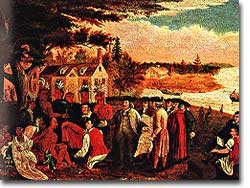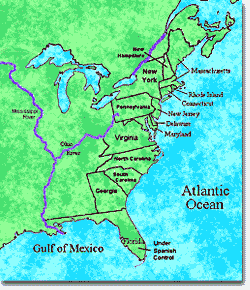
4. The Middle Colonies

William Penn paid 1200 pounds for the land he purchased from the Delaware Indians.
Americans have often prided themselves on their rich diversity. Nowhere was that diversity more evident in pre-Revolutionary America than in the middle colonies of Pennsylvania, New York, New Jersey, and Delaware. European ethnic groups as manifold as English, Swedes, Dutch, Germans, Scots-Irish and French lived in closer proximity than in any location on continental Europe. The middle colonies contained Native American tribes of Algonkian and Iroquois language groups as well as a sizable percentage of African slaves during the early years. Unlike solidly Puritan New England, the middle colonies presented an assortment of religions. The presence of Quakers, Mennonites, Lutherans, Dutch Calvinists, and Presbyterians made the dominance of one faith next to impossible.

The middle colonies included Pennsylvania, New York, New Jersey, and Delaware.
Advantaged by their central location, the middle colonies served as important distribution centers in the English mercantile system. New York and Philadelphia grew at a fantastic rate. These cities gave rise to brilliant thinkers such as Benjamin Franklin, who earned respect on both sides of the Atlantic. In many ways, the middle colonies served as the crossroads of ideas during the colonial period.
In contrast to the South where the cash crop plantation system dominated, and New England whose rocky soil made large-scale agriculture difficult, The middle colonies were fertile. Land was generally acquired more easily than in New England or in the plantation South. Wheat and corn from local farms would feed the American colonies through their colonial infancy and revolutionary adolescence.
The middle colonies represented exactly that — a middle ground between its neighbors to the North and South. Elements of both New England towns and sprawling country estates could be found. Religious dissidents from all regions could settle in the relatively tolerant middle zone. Aspects of New England shipbuilding and lumbering and the large farms of the South could be found. Aptly named, they provided a perfect nucleus for English America.





